Complimentary worldwide shipping on orders over $400 · No import tariffs for most countries
Complimentary worldwide shipping on orders over $400 · No import tariffs for most countries
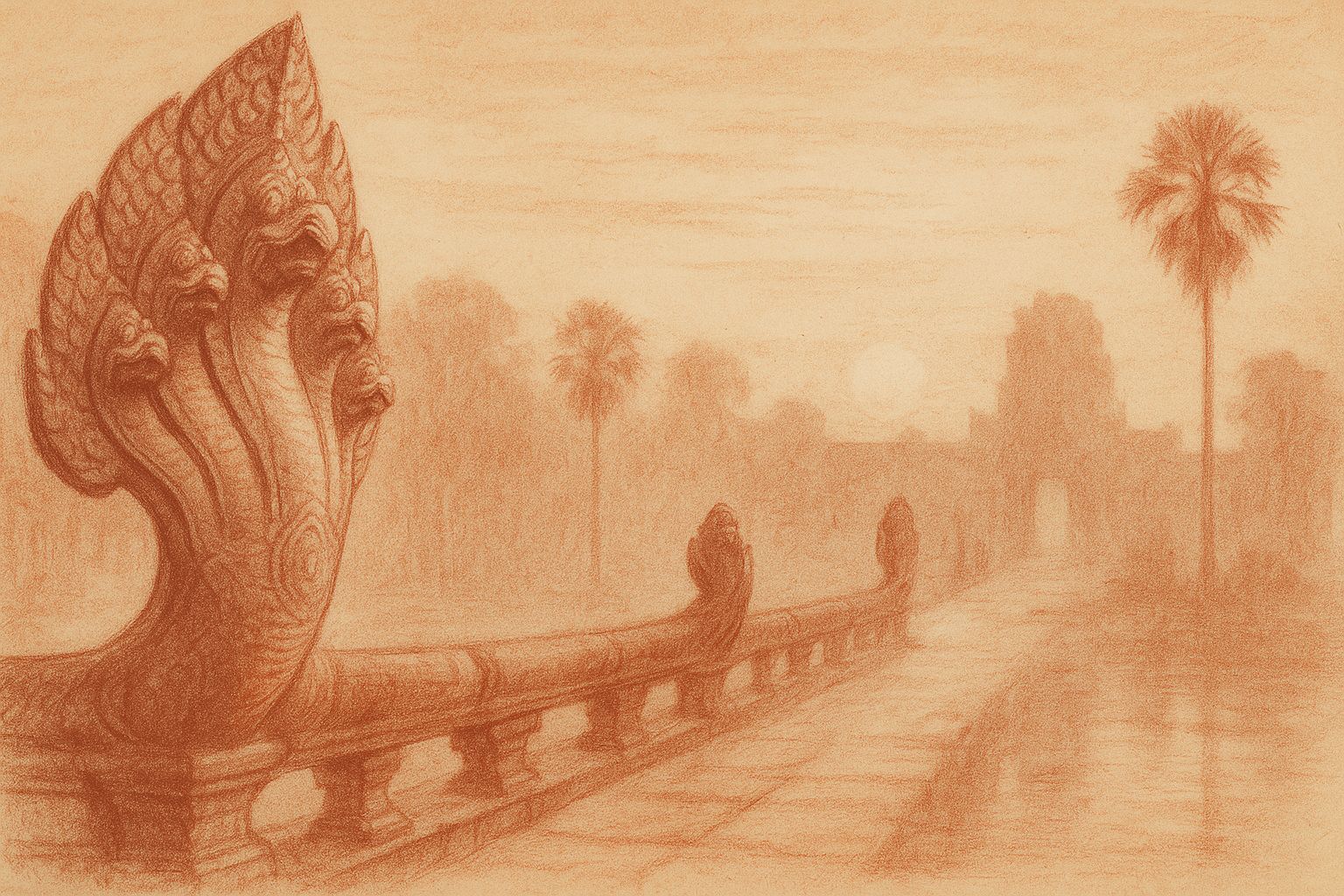
Garuda and the Serpent · Flight and Surrender
4 min read
Between the feather and the scale, the world is held.
Few pairings in sacred imagination endure with such tension and tenderness as Garuda and the Nāga—the bird of the heavens and the serpent of the deep. Each seems born to oppose the other, yet both move according to one rhythm. One belongs to light and motion; the other to darkness and repose. One cuts the sky like a blade of fire; the other coils through water and earth, carrying the hush of beginnings. Between them the Khmer sculptors discovered the architecture of balance—the breath between flight and root, wind and river, sky and stone.
Across Angkor’s causeways this dialogue becomes visible in the very fabric of the approach. The pilgrim who walks toward the central sanctuary walks upon the back of the serpent: the Nāga unfurling its scaled spine as bridge, seven or nine hoods rising in a crown of protection. Beneath, Garudas crouch at intervals, wings straining, talons sunk into the serpent’s coils. The ensemble lifts and anchors at once, as though the temple itself inhales through their entwined bodies.
In the cosmology that shaped the empire, Garuda and the Nāga are not mere creatures of myth but the living currents of the world. Garuda is air, will, spirit—the divine wind that carries both prayer and revelation. The Nāga is water, memory, the hidden pulse beneath soil and stone. The Khmers inherited this duality from India yet made it their own: the battle between bird and serpent transformed into meditation on interdependence. For all his splendour Garuda cannot rise without the breath that gathers from the waters; for all her depth the Nāga cannot endure without the descent of rain from the sky.
At Angkor, their struggle ripens into serenity. In early reliefs Garuda claws at serpents, beak sharpened with divine fury. Centuries later the two merge—a serpent with wings, a bird ringed in scales—until conflict becomes symmetry. Roveda traces this union to Vishnu’s dual repose: the god asleep upon the serpent Ananta before awakening to ride upon Garuda. Rest and motion, surrender and ascent—two gestures of the same grace.
The pilgrim senses this long before naming it. Step onto a temple bridge at dawn and the air vibrates with dragonflies. The moat lies still, yet the reflections tremble: palms wavering like feathers, the serpent balustrade dissolving into sky. Each step is a crossing between elements—water to earth, darkness to light, silence to sound. The Nāga bears the body’s weight; the Garudas bear the soul’s intent. Together they form a single act of breathing, the movement by which devotion advances.
In Khmer legend the Nāga is ancestress as well as guardian: daughter of the serpent-king who rose from the sea to marry the Brahmin Kaundinya, mother of the first Khmer line. To be born of her is to belong to rain and river. Garuda enters later as the divine mount of Vishnu—the quickening wind, the brilliance of the sun. Their meeting is therefore the marriage of two cosmologies, native and imported, fused in stone.
The artisans knew this. In each lintel their contest unfolds with musical precision: talon answered by coil, wing by hood. Look closer and the violence melts to grace. The Nāga’s body curves like a river around the bird; the bird’s wings encircle the serpent as though protecting her. These are not foes but forces in dance—tension and release, ascent and return. The carving becomes a diagram of breath, each line cut to catch the shifting light.
Hence their place at every threshold. Each causeway, gate, and terrace guarded by Garuda and Nāga marks passage between worlds. One cannot reach the sanctuary without walking the serpent’s spine, cannot glimpse the towers of Meru without passing beneath the bird’s gaze. The builders teach through movement: to approach the sacred, one must balance opposites—fly while remaining rooted, yield while advancing.
The same law underlies the Churning of the Ocean of Milk. Gods and demons grip the Nāga Vasuki as rope, drawing back and forth until amrita, the nectar of immortality, is born. Garuda, watcher of the heavens, guards the elixir. Creation emerges not from victory but from measured tension. The Khmer understood: harmony, not triumph, sustains the world.
To modern eyes Garuda may appear emblem of conquest—the spirit of freedom tearing from the coils of earth. Yet in Angkor’s stillness flight is never escape. To rise is to trust the pull that will draw one home. Likewise, the serpent’s descent is not defeat but devotion: she coils because she knows the air still holds her. The wisdom of the Nāga is patience; the wisdom of Garuda is faith. Between them the universe keeps its poise.
High at Preah Vihear, wind scours the mountain steps. The Nāgas curve downward, scales worn to pewter by centuries of sun; between their hoods faint Garudas persist, wings folded in stone. The ascent becomes remembrance: each step both letting-go and grounding—the pilgrim’s prayer made physical.
Seen thus, the entire Angkorian plain reveals their embrace. The barays cradle the mirrored sky; towers rise from reflections; clouds gather and return as rain. Even the temples breathe through this rhythm—stone exhaling air, roots drinking water, civilisation poised between rising and sinking.
At dusk, when bats replace swallows and moats turn to silver glass, the carvings speak their quiet truth. The myth is not of dominance but of continuity. The Nāga’s water nourishes the rice; the Garuda’s wind carries the monks’ chants. Without the serpent’s endurance the bird would burn; without the bird’s vigilance the serpent would drown.
So the Khmers joined them in sculpture and prayer. They knew the world survives through tension held in compassion—that even the fiercest opposites must bow toward equilibrium. To see Garuda clasping the serpent at Angkor Wat is to witness the cosmos teaching itself to breathe.
And the pilgrim, watching, learns the same. Freedom and surrender are not opposites but twins. To resist gravity is to depend upon it; to yield is to prepare for flight. Between feather and scale lies the heart of devotion—the meeting of sky and sea, of wind and memory—where the spirit, balanced between, discovers that stillness itself can fly.
Also in Library
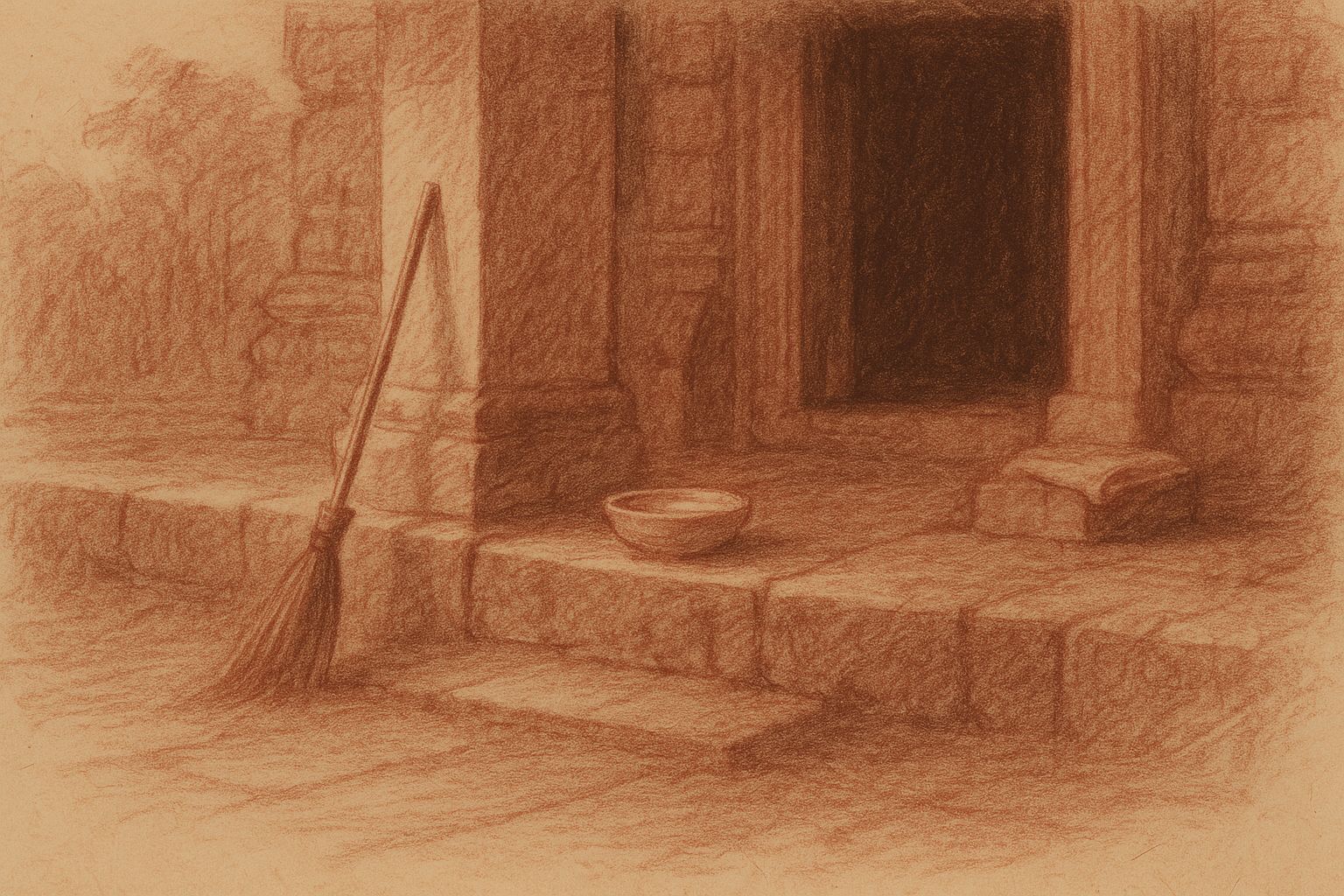
Those Who Keep the Way Open — On the Quiet Guardians of Angkor’s Thresholds
3 min read
Quiet gestures shape the way into Angkor — a swept stone, a refilled bowl, a hand steadying a guardian lion. This essay reflects on the unseen custodians whose daily care keeps the thresholds open, revealing how sacredness endures not through stone alone, but through those who tend its meaning.
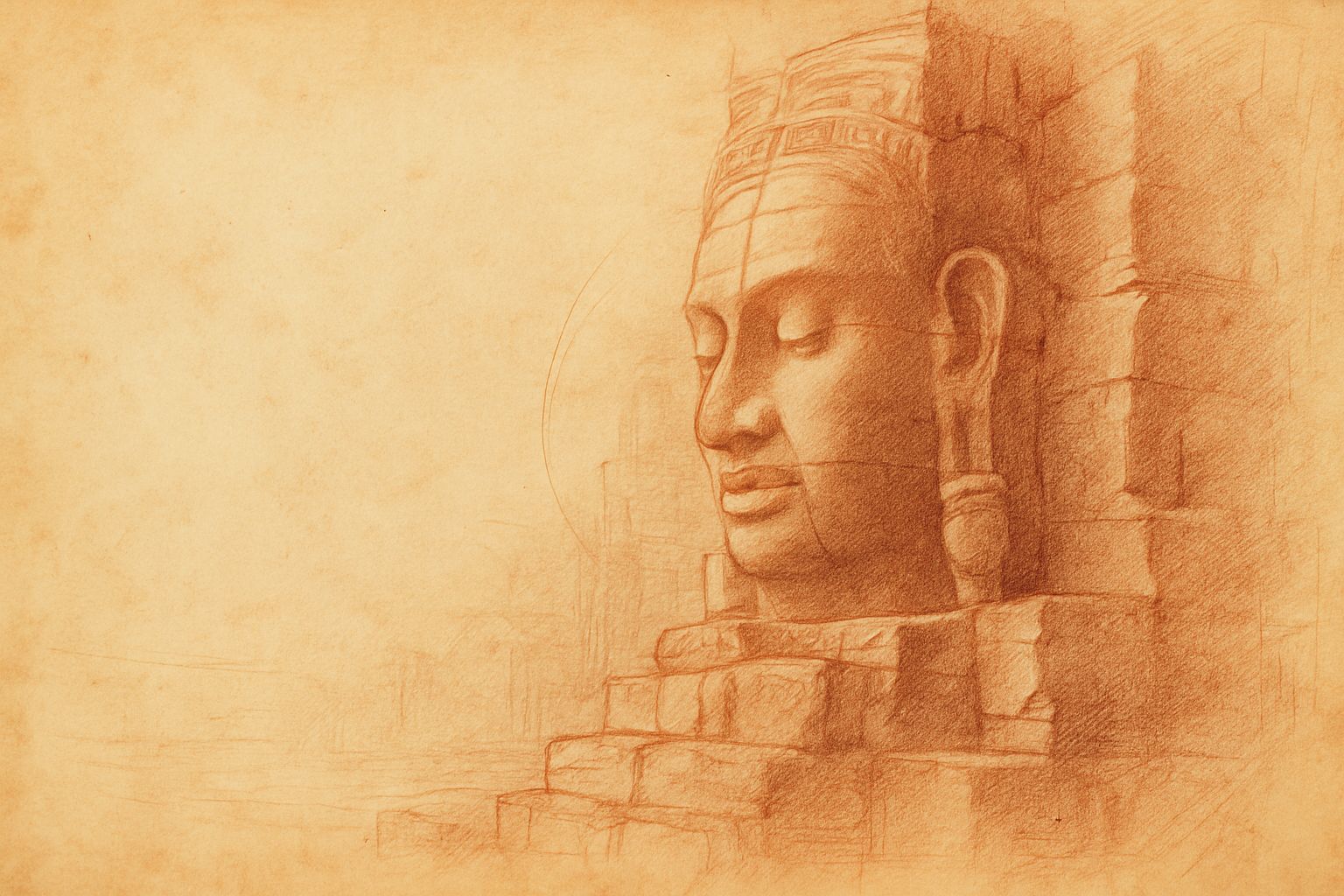
Multiplicity and Mercy — The Face Towers of Jayavarman VII
5 min read
A new vision of kingship rises at the Bayon: serene faces turned to every horizon, shaping a world where authority is expressed as care. Moving through the terraces, one enters a field of steady, compassionate presence — a landscape where stone, light, and time teach through quiet attention.
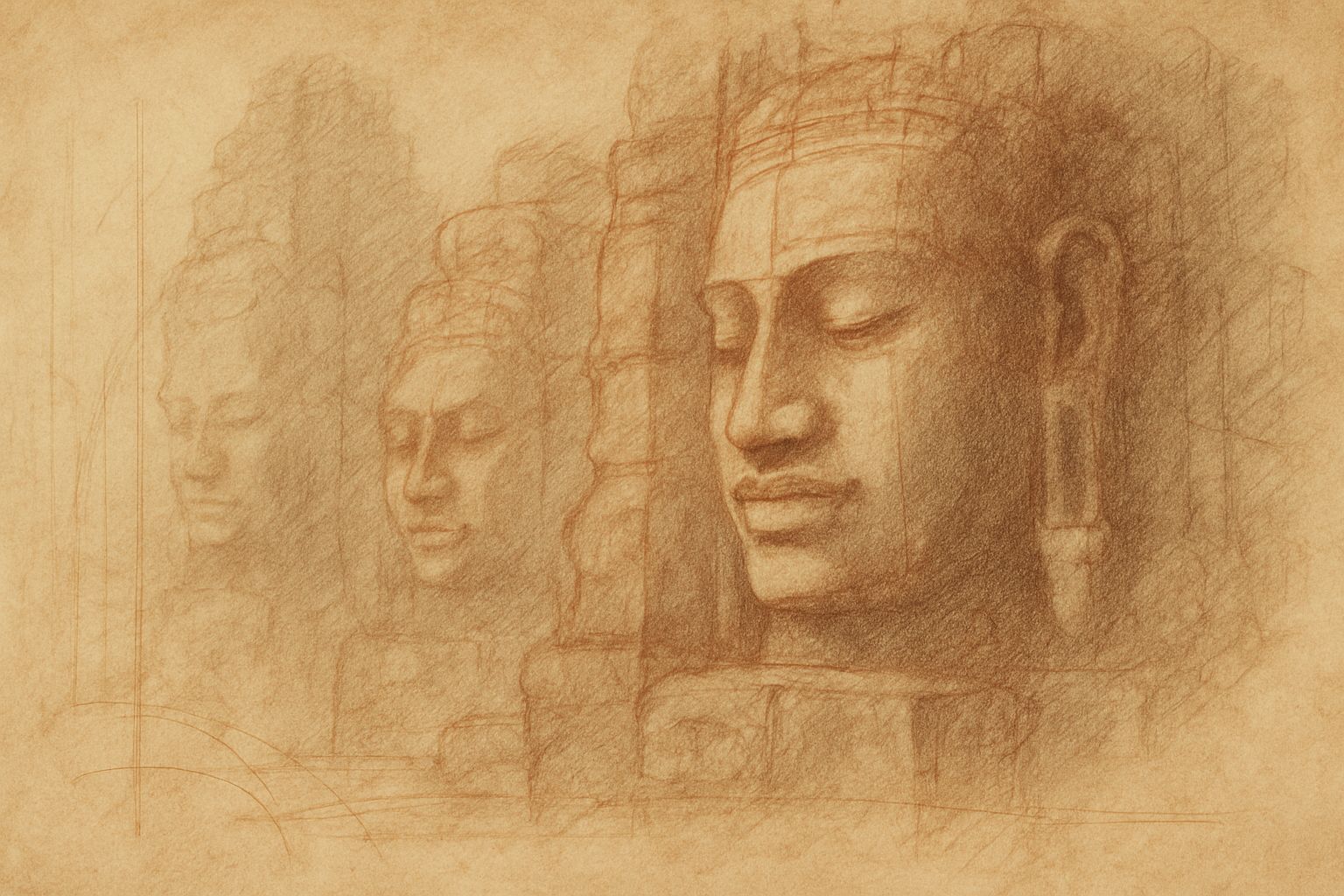
Stone That Dreams
4 min read
Bayon wakes like a mind emerging from shadow. Its many faces shift with light and breath, teaching that perception—and the self—is never singular. In walking this forest of towers, the pilgrim discovers a quiet multiplicity within, held together by a calm that feels both ancient and newly understood.
Join My Studio Journal
Receive occasional letters from my studio in Siem Reap—offering a glimpse into my creative process, early access to new fine art prints, field notes from the temples of Angkor, exhibition announcements, and reflections on beauty, impermanence, and the spirit of place.
No noise. No clutter. Just quiet inspiration, delivered gently.
Subscribe and stay connected to the unfolding story.
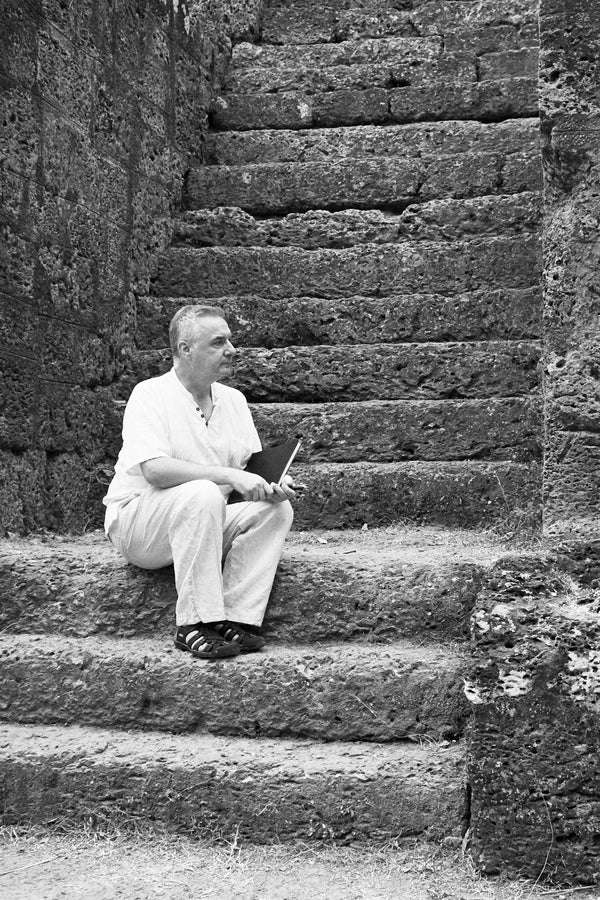
Join My Studio Journal
Receive occasional letters from my studio in Siem Reap—offering a glimpse into my creative process, early access to new fine art prints, field notes from the temples of Angkor, exhibition announcements, and reflections on beauty, impermanence, and the spirit of place.
No noise. No clutter. Just quiet inspiration, delivered gently.
Subscribe and stay connected to the unfolding story.
